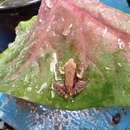en
names in breadcrumbs


The dark-sided frog, Hylarana nigrovitatta, was first described from Myanmar as Limnodytes nigrovitatta in 1856.The species is widely distributed in continental Asia, from Eastern India, through southern China (Yunnan province) Myanmar, Thailand, Lao People's Democratic Republic, Viet Nam, Cambodia, the northern half of Peninsular Malaysia and extending to the Thai island of Phuket. While H. nigrovitatta occurs up at altitudes of 60-1,200 m above sea level, it is most common in drier, lowland forests at 200-600m asl (Van Dijk et al. 2004).
Hylarana nigrovitatta appears to comprise a species complex with at least three different morphotypes, and further research will likely distinguish boundaries subdividing H. nigrovitatta into several species across this wide range (van Dijk et al. 2004; Baker 2016).For example, Gawor et al. (2009) discuss adult, larval and molecular variation that indicates Vietnamese and Thai populations are distinct at the species level.While across its range this species (sensu lato) appears stable, further study of unknown cryptic species subsumed within H. nigrovitatta may indeed be in need of conservation measures.
Adults are found on the sandy banks of streams, ponds, and pools, hiding under rocks, logs, crevices and vegetation. Though they predominantly inhabit primary forests, they can adapt to disturbed areas, and sometimes can be found in areas inhabited by humans, such as in town gutters and drains.They are a distinctive frog, with a pointed snout, slender medium brown colored body, and reach a maximum size of 75mm.They have characteristic broad, black lateral stripes that runs from the snout across the eye and external tympanum, along the body side to the hind limbs.The hind limbs have dark mottling or stripe markings.Primarily nocturnal, males call regularly in the evenings, though adults can be found active during the daytime.
Adults breed in dry season (September-March), and starting in early October females deposit small, dark-colored, jelly-coated eggs onto the water surface, where they float on the surface (in Thailand; Gowor et al. 2009, 2011).Eggs hatch after just a few days into tadpoles, that measure 2-3 mm and hang vertically in the water column. After 7-10 days, tadpoles live in abundance on the sandy surface of the water. Young tadpoles have light pigmentation that darkens to brown-olive marbled coloring on their dorsal surface as they age, and a slightly transparent, light olive coloring on their ventral side.During the day, the tadpoles hide by lying still on algae layers.The tadpoles develop rapidly into froglets and leave the water in 50-70 days (Gowor et al. 2011).Researchers have successfully bred H. nigrovittata (from Thailand) in the laboratory (Gowor et al. 2009; 2011), and the development of these frogs is well documented.
Note Frost et al. (2006) and various other molecular studies classify this taxon as Sylvirana nigrovittata (Frost 2015).
Sylvirana nigrovittata, also known as the black-striped frog, black-spotted stream frog, sapgreen stream frog, etc., is a species of frog in the family Ranidae. It is found in northeastern India, Bangladesh, Nepal, southern China, Myanmar, Thailand, Cambodia, Laos, and Vietnam. The species was redelimited in 2018, and earlier literature may refer to other species; identifications from India and Bangladesh are still uncertain.[2]
Sylvirana nigrovittata occurs in gentle streams in evergreen forest, including evergreen galleries in deciduous forest areas. The tadpoles develop quiet stream sections. It is a common species. It is threatened by the loss of forest canopy over streams it inhabits, as well as hydrological changes. It is not considered threatened by the IUCN.[1]
Sylvirana cf. nigrovittata, Khao Luang National Park
Sylvirana nigrovittata, also known as the black-striped frog, black-spotted stream frog, sapgreen stream frog, etc., is a species of frog in the family Ranidae. It is found in northeastern India, Bangladesh, Nepal, southern China, Myanmar, Thailand, Cambodia, Laos, and Vietnam. The species was redelimited in 2018, and earlier literature may refer to other species; identifications from India and Bangladesh are still uncertain.
Sylvirana nigrovittata occurs in gentle streams in evergreen forest, including evergreen galleries in deciduous forest areas. The tadpoles develop quiet stream sections. It is a common species. It is threatened by the loss of forest canopy over streams it inhabits, as well as hydrological changes. It is not considered threatened by the IUCN.

Sylvirana cf. nigrovittata, Khao Luang National Park

Sylvirana cf. nigrovittata, Khao Luang National Park